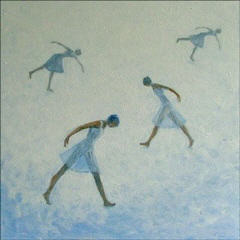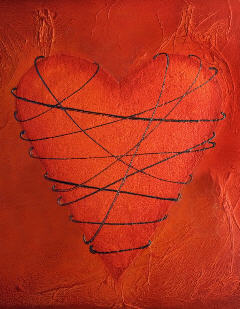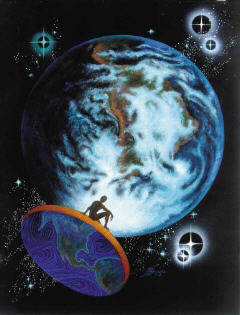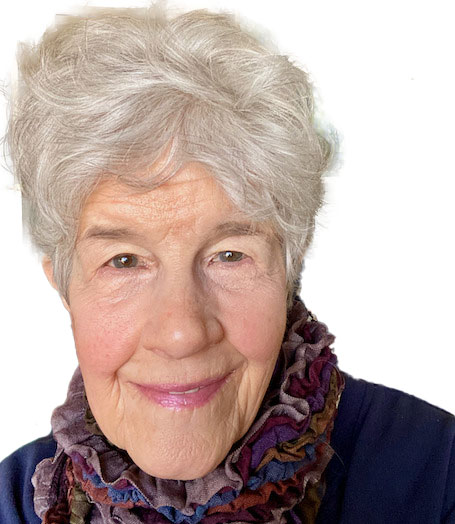This article isn’t about EFT specifically, but it may be worth reading anyway.
- You will get some ideas about how to bring in your imagination to advance a session.
- It raises some important questions:
- How do we know when healing has taken place?
- What is healing, anyway?
When Chloe came with a pain in her leg, it was my initial intention that we tap for the pain. Tappable issues did come up, but in this session the information-gathering process took on a life of its own. I have learned to go with what is happening when we tap, if what is happening feels right in the moment. As the “Story People” card on my desk says, “If you hold on to the handle…it is easier to maintain the illusion of being in control. But it’s more fun if you just let the wind carry you.”
Chloe’s leg pain hadn’t been responding to chiropractic or massage or physical therapy. She described her leg in pretty vivid terms, as “dead meat,” cold, achy, and oddly better when she was on hikes. The feeling was intense, a 7 or 8. She had no idea, however, why her leg was hurting.
Casting about for the cause, we couldn’t find any link to experiences that would suggest the physical or emotional source of this pain. Because I am really interested in the ancestral themes that we live out in our families over the generations, I asked Chloe about her family. Was there anyone else who had had “leg stuff?” Thinking about it, she was surprised to realize that everyone in her immediate family had had some leg issues: her father had been in a World War II trench and had developed a severe leg infection, her brother had trouble with his hip and ankle, her sister had broken her hip, and her grandmother had had gangrene in her leg from diabetes.
I got to wondering if there was somehow an ancestral “leg story” being played out here in her leg and her life. She had no idea, so I asked her a question that often serves to “start” a person’s imagination. The imagination needs material to work with, even if we are “just making it up,” and it draws from our own experience, even if the information comes from below our conscious awareness. I believe that what we call imagination is a living presence of deep truth in us.
So I asked Chloe to begin to make up a story about someone, maybe a woman, with pain in her leg that felt cold and made her leg feel like “dead meat.” It turned out that she had a great imagination.
 She had an immediate image of a woman walking and walking through endless ice and snow in the countryside, “fleeing from somewhere,” she said. There was frostbite and exhaustion but they had to keep walking. “The one I am seeing,” she said, “is one who seems like me. Her legs got so cold that her nerves started dying, but she had to keep walking. She was so tired, there were rags on her feet, her legs were failing, but she had to keep walking.”
She had an immediate image of a woman walking and walking through endless ice and snow in the countryside, “fleeing from somewhere,” she said. There was frostbite and exhaustion but they had to keep walking. “The one I am seeing,” she said, “is one who seems like me. Her legs got so cold that her nerves started dying, but she had to keep walking. She was so tired, there were rags on her feet, her legs were failing, but she had to keep walking.”
This imaginal story seemed to be set in a war time. She sensed that there were horrible experiences that she had to be witness to, so horrible that she got numb, and couldn’t feel anything, either emotionally or in her legs. After the war she had the feeling of having seen too much, been part of too much. (I was writing all this down as she spoke slowly, eyes closed, seeing the story unfold.)
In this time, in the now, Chloe began to cry. “I work now as a therapist with people who have post-traumatic stress. They have experienced such horrible, sad, tragic things. This story resonates with theirs. I have had to become numb in order to hear their stories. I am concerned for myself.”
Her leg felt “frozen, mushy, cold.” She had an intuitive sense that in some way she deserved this pain. All of this information felt relevant, even though it had emerged from an apparently made-up story.
I asked her to hold the feeling of “deserving this pain,” and notice what thoughts and feelings arose when she asked inside about everything, across space and time, that could have led to the pain in her leg and whatever it was about.
She then had a sense of a Jewish voice speaking up in her. The Jewish voice said: “You people (her heritage is German) exterminated six million of us. You burned us. You took everything from us. You killed our little children, our mothers and fathers. You made our lives not worth living. If you had to feel a little bit of what it was like for us, that is not even 1/100 of what we had to feel. If you have this physical pain now, it serves as a reminder, a little sign, to remind you so you don’t ever forget what your people did to my people. I don’t forgive you. I will always be afraid of you and your people. I will always think that you could do it again. I will never take my eyes off of you.”
 I asked if we could call in another voice, a spiritual ally, who could respond from the same kind of powerful center inside that this Jewish voice spoke from. Chloe was willing, and went inside again. I spoke some words of invitation for allies to come forth. (She liked my term “spiritual allies” because she didn’t believe in angels, she said.) She paused until she got a sense of an inner response.
I asked if we could call in another voice, a spiritual ally, who could respond from the same kind of powerful center inside that this Jewish voice spoke from. Chloe was willing, and went inside again. I spoke some words of invitation for allies to come forth. (She liked my term “spiritual allies” because she didn’t believe in angels, she said.) She paused until she got a sense of an inner response.
The voice that spoke now said to the Jewish voice, “I understand your pain, your suffering, your fear, and your rage. It is pain and anger that is held in many people and in many spirits. You have a right to it if you want it. I want you to know that this human being that you are talking to is from that ancestry on the world level. But she is not from that ancestry on a spiritual level. I have sent her here especially to bring light and love into the world. On the one hand it is right that you have come to meet her, because she can hear you and spread your message. On the other hand, it is not right to make this person responsible. She is not spiritually responsible for those historical actions.
“So there is a dilemma. She is the kind of person who is willing to and can be a representative of an ancient ability to take on the responsibility for pain and suffering and horror. But she doesn’t know how to un-identify with it now. It weakens her. Her holding this pain in her body and her heart can not do you any good. She needs to be able to hear you in a way that doesn’t weaken her, because weakened by this suffering that she holds, she can’t do the larger healing work that we all need.”
Following my intuition, I asked Chloe to imagine that she could take a perspective of looking from above these two voices, aware of both of them at the same time but from a broader, deeper point of view. I called this other view the Spirit of Humanity.
Immediately she saw herself standing beside the body of her self that had been suffering. She was moving to the right of it, and “walking forward in my new story. I am walking on a path that is made out of light. The light shines on the path, and on me. People are coming from the darkness. They hold out their hands, and I pull them in to walk beside me on the path of light. I have the image that people are emerging from the dark to walk on this path. The path gets broader and broader. My job is to take their hand so that they can get on the path.”
 “As I walk on this path of light with them” she continued, “the path keeps sending light up through my legs into my body and into my heart. Light is also constantly streaming down through my head into my body and my legs and into the earth.
“As I walk on this path of light with them” she continued, “the path keeps sending light up through my legs into my body and into my heart. Light is also constantly streaming down through my head into my body and my legs and into the earth.
“Now the part of me that is on the path of light holds out its hand to the part of me that has been in darkness. My arm around its shoulders, together we walk. I am warming up.”
Chloe noticed some resistance inside herself to warming up. I asked what might be the positive intention of that resistance. What was it trying to get for her? “Hmmm…” she said, “If I got warm and my leg felt good, I might be too happy. I wouldn’t hold on to my awareness of suffering. I would be irresponsibly carefree.”
She talked about how wonderful it was, on the other hand, to work as a therapist with people who were really ready for change, and how healing it was for her as well when she and her client were both able to move together into the light of joy.
She talked about how, on the other hand, some of the really traumatized people she saw had such a hard time moving out of the story of their sorrow and pain and darkness. She felt she was there to serve them. But it was draining and difficult, and she had had to numb herself to be able to help them.
Here was a dilemma.
- part of her was holding on to pain so she wouldn’t be “irresponsibly carefree”
- how healing it was for her to work with shared joy
- she had to numb herself to be able to help traumatized people
Then she said an interesting thing. “I can see how good it is to be able to do this work with joy. It is good for me and for the people who are ready to move out of their darkness. So I will devote a certain percentage of my practice now to those clients.” I translated this to mean “I will allow myself a little joy so that I have the energy to work with traumatized people.” I didn’t feel a balance in this.
 I invited Chloe to imagine “thinking like a planet.” I asked her to imagine actually being the earth, with everything going on in and on it, and all the human activity.
I invited Chloe to imagine “thinking like a planet.” I asked her to imagine actually being the earth, with everything going on in and on it, and all the human activity.
Then I suggested that she imagine a therapist over here (gesturing to one side) who was very earnestly and diligently doing “good work,” helping people who were suffering, trying to save the world. I could feel my own body all hunched over as I talked about the effort of “doing good.”
“Now, imagine over here,” I said, gesturing in the other direction, “a person who is full of love and lightness and joy and happiness, whatever she is doing, partnering with people who are ready and able to feel this inner lightness of being, each of them radiating these qualities into the body of the earth as they co-create.
“Being the earth,” I said, “feeling into both of those ways of being, notice which of these two ways of working feels best to you? Which one seems to you to be adding the most blessing and healing to you, as the earth?”
Of course she could see and feel how much more effective even the small acts of joy and love were.
“What would it be like to always do your work, or anything you do, for that matter, in ways that bring you joy?” I asked. “Adding a radiance of joy to the earth might be much more therapeutic all the way around!” She was nodding, thoughtfully.
Just before Chloe left, she said “I think the pain in my leg was acting like a hobble. Some part of me thought I should keep the awareness of pain and suffering as a payback, paying my German dues. That is why I thought I had to numb myself to heal other people’s trauma. Now I know that I am free to practice turning toward joy.”
Here at the end of the session Chloe’s leg felt somewhat better. It still hurt.
Was there healing?
With my love and blessings,
— Rue


